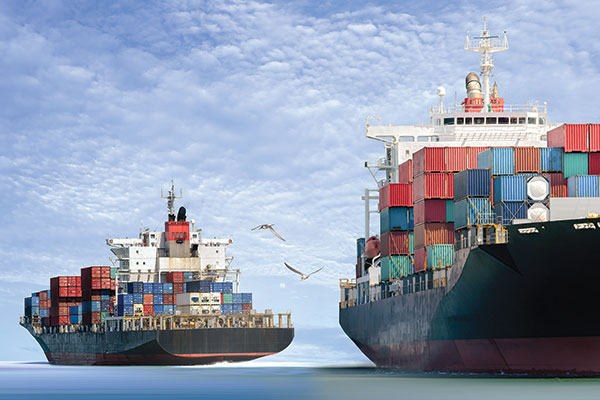2022 Trade Update: How to keep freight moving

Shippers who are current on the global trade landscape are assets to their service partners and customers. Our global trade expert provides us with a review of the key trade topics that should be top of mind as we enter 2022.
The year 2021 was one of uncertainty for trade compliance with the new Biden administration coming into office. And while we didn’t see any change of policy on trade with China, we did see a promise from this administration of supporting more domestic production to prevent disruption in the supply chain.
In the meantime, supply chain delays are beginning to ease, but there are still record numbers of ocean vessels off the coast of Los Angeles and Long Beach waiting to offload and a host of empty containers that are waiting for a returned journey on those same vessels—and it might be a while until we get back to “normal.”
So, with all of that in mind, here are some other key international trade areas shippers should consider as we roll into 2022.
HTS in 2022
As many global shippers are aware, the World Customs Organization (WCO) reevaluates the Harmonized Tariff Code every five years. The WCO completed its latest review in 2019, approving some 350 amendments to the Harmonized Tariff Schedule (HTS) that will be enforced on January 1, 2022.
This update affects tariff codes and their associated tariff rates in more than 200 countries. There are some themes behind the HTS 2022 amendments including new technologies, environmental and health concerns, and ways of tracking “dual use” items to measure the movement of civil and military items in and out of the U.S. Some notable changes pertain to smartphones, unmanned aircraft, parts of aircraft, 3D printers and LEDs.
If shippers are using a global trade management system software provider for their HTS content, they should already know what part numbers need to be reclassified. However, many small- to medium-sized companies might still be maintaining their classifications manually by spreadsheet or other method.
If their freight forwarders or Customs brokers are not provided with a shipper’s product list with the revised 2022 HTS classification numbers, there will most likely be delays at the port of entry. Shippers should take immediate action to evaluate the 2022 changes so their imports are not impacted. The changes can be found the WCO website (wcoomd.org).
Section 301 tariffs against China
The Biden administration has not made a move to reduce or eliminate the Section 301 tariffs against imports of Chinese goods. The tariffs range, but are up to 25% in addition to the regular tariff amount and have caused companies to pass the additional cost onto consumers or change their supply chains to avoid these additional duties.
After the Section 301 tariffs were proposed, companies could argue that they needed an exemption for their products if they could prove certain criteria such as no other sourcing options other than China. Of the 99 COVID medical supply-related exclusions, only 81 are still valid until May 31, 2022, and can be found at federalregister.gov.
Otherwise, all exclusions for COVID and non-COVID related products have expired. In early October 2021, the U.S. government decided to reconsider an exclusion process that could lead to the reinstatement of certain exemptions from tariffs imposed on 549 Chinese products. The due date for comments was December 1, 2021. Stay tuned as to whether the exemptions are reinstated in 2022.
Additional export controls
While the 2022 HTS update is predictable, the U.S. Department of Commerce’s Bureau of Industry and Security (BIS) sporadically issues new export regulations and proposed regulations on certain items, software and technology.
BIS has been focused recently on emerging technologies such as artificial intelligence. The products and software using certain emerging technologies are classified under new or expanded Export Commodity Classification Numbers (ECCNs).
- BIS added ECCN 2D352 in early October, 202, for software for nucleic acid assemblers/synthesizers and its related technology for developing the software. This is software that’s capable of designing and building functional genetic elements from digital sequence data. This software is heavily controlled for chemical and biological weapon concerns. It does not have any license exceptions available and will require an export license for the physical shipment and software downloads to most countries.
- BIS is also currently seeking comments on recently proposed controls on brain-computer interface (BCI) technology. Examples of BCI technology include neural-controlled interfaces, mind-machine interfacesm direct neural interfaces, and brain-machine interfaces. Comments were due to BIS by December 10, 2021. There could be a decision by BIS on how to control this technology for exports by mid-2022.
- In January, 2020 BIS published a rule for geospatial imaging software under ECCN 0D521. Software under this ECCN warrant control for export because the items may provide a significant military or intelligence advantage to the United States or because foreign policy reasons justify control. The ECCN 0D521 series is a temporary holding classification. The rule was renewed in January 2021, but a specific ECCN was not issued. If BIS does not renew the current rule or create a new ECCN by January 6, 2022, the 0D521 classification will expire as it applies for geospatial imaging software and it will revert back to an EAR99 classification.
- In October, 2021 BIS issued an interim final rule (federalregister.gov) that introduces five new ECCNs and a new license exception for cybersecurity that will be effective January 19, 2022. The new ECCNs would be 4A005 and 4D004, new paragraph 4E001.c, and a revised 4E001.a and 5A001.j. While these ECCNs are new to the U.S. export regulations, the E.U. adopted these back in 2014. These ECCNs cover items, software and technology that could be used for surveillance, espionage, or to disrupt networks. The new license exception is called Authorized Cybersecurity Exports (ACE). This new exception would allow “the export, re-export and transfer [in-country] of ‘cybersecurity items’ to most destinations, except to destinations listed in Country Groups E:1 and E:2 [currently Cuba, Iran, North Korea, and Syria], with some differentiation between government and non-government end-users and end-use restrictions.”
Shippers need to stay abreast of these changes in order to avoid violations, potential shipment delays or seizure of their products if they are not using the correct ECCN, license or license exception on their documentation and export declarations.
Also note that the related technologies might require deemed export licenses for certain foreign nationals (e.g. H1-B visa holders) that are developing these technologies or using them to develop products and software while working in the United States.
Global Business Indicator (GBI)
U.S. Customs and Border Protection (CBP) has introduced a pilot program for the new Global Business Indicator (GBI) initiative, which proposes replacing current manufacturer/shipper ID codes (MID) with a new ID system that provides the CBP with more transparency to identify the main legal entity and ownership, specific business and global locations, and supply chain roles and functions.
The pilot will have importers use the Data Universal Numbering System (DUNS), Global Location Number (GLN), and Legal Entity Identifier (LEI) to determine the optimal combination for the GBI. The GBI pilot program is expected to go live in the Spring of 2022. There won’t be mandatory reporting of GBI, but the pilot will be live and available for those who want to participate.
The reason behind the program is because of the increased volume of import/export activity in the U.S. introduces an unacceptable level of risk. The CBP wants more information on cargo entering and exiting the U.S. to help identify high-risk cargo and to make the whole system more efficient and transparent. More can be found at cbp.gov.

Trade compliance training
Shippers dealing with international trade should have a companywide trade compliance training program in place that provides an overview of the high-risk areas the company encounters based on their products, technologies and where they do business around the world.
More in-depth training should be performed for specific groups such as logistics managers where documentation and recordkeeping are emphasized, or for sales, order management and customer support where sanctions, embargoes and restricted party screening are emphasized.
The individuals responsible for trade compliance need to stay abreast of and plan for each change surrounding Section 232 tariffs, Section 301 tariffs, new USMCA changes, Brexit and retaliatory tariffs.
Trade compliance training seminars and conferences such as the BIS Update and U.S. Customs Symposiums and webinars are great ways to stay updated and are now offered virtually. Training is a company’s greatest ally in protecting your organization against trade compliance risks.
The year 2022 will bring many of the same issues for shippers as 2021, and shippers should expect more twists and turns in the trade compliance arena. Even if supply chain woes do ease, don’t let the new CBP and BIS regulations slow down your freight once it arrives at the border.













